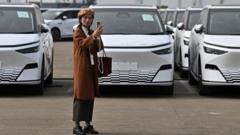In 2024, SUVs comprised 54% of global car sales, contradicting earlier UN predictions for a more sustainable vehicle landscape as the climate crisis escalates.
The SUV Surge: A Climate Dilemma in the Face of Predicted Electric Vehicle Growth

The SUV Surge: A Climate Dilemma in the Face of Predicted Electric Vehicle Growth
Despite forecasts for a shift towards smaller electric cars, SUVs dominate the automotive market, raising environmental concerns.
Across the globe, Sports Utility Vehicles (SUVs) are increasingly dominating both urban and rural landscapes, even as experts and organizations like the United Nations predicted a transition towards smaller, environmentally-friendly cars in light of the climate crisis and rising living costs. A recent report reveals that in 2024, SUVs, encompassing all types including hybrid and electric variants, accounted for 54% of car sales worldwide—a notable rise from previous years. This trend contradicts expectations for a more sustainable shift, as the International Energy Agency (IEA) highlights that a staggering 95% of the current SUV fleet relies on fossil fuels.
Even though manufacturers claim to be increasing their electric offerings, environmental activists argue that the environmental toll of SUV production remains significant. These vehicles, known for their substantial size and weight, demand extensive resources to manufacture and require larger batteries for electric versions, thus escalating the extraction of critical minerals essential for battery production.
While many believed that smaller electric vehicles (EVs) would witness skyrocketing sales, the reality paints a different picture. Traditional electric car sales have dwindled in significant markets like Japan and Germany, and the overall sales growth in India has stagnated. In Europe, the dominance of SUVs has overtaken the sales of electric vehicles, as illustrated by a decline in small hatchback sales since 2018. This data indicates a shifting consumer preference towards spacious, dual-purpose vehicles, particularly in developing economies where increasing purchasing power favors SUV acquisition.
Industry leaders suggest that consumer demand drives this trend; the practicality, comfort, and elevated driving position of SUVs appeal to many drivers. Additionally, automobile manufacturers benefit from the higher profit margins SUVs allow, making them a lucrative segment to market aggressively. As marketing campaigns elevate the desirability of SUVs, they become not just practical choices but aspirational symbols.
However, the ecological ramifications of mounting SUV sales are dire. The IEA reports that global oil consumption from SUVs surged by 600,000 barrels per day from 2022 to 2023, contributing significantly to the overall rise in oil demand. If categorized as a nation, the collective emissions from the global SUV fleet would rank fifth in terms of CO2 output, surpassing emissions from countries like Japan. Their heavier weight results in an average increase in fuel consumption by 20% compared to medium-sized vehicles. Road transport alone accounts for over 12% of global carbon emissions, compounding the urgency for immediate decarbonization across all sectors to avert climate catastrophe.
Responding to these concerns, industry experts maintain that not all newly launched SUVs exacerbate emissions. Remarkably, the percentage of zero-emission SUV models sold has risen from 2% in 2018 to over 20% in 2023. Nonetheless, studies indicate that many hybrid vehicles only utilize electric mode for a small portion of their travel. The momentum towards heavier, less efficient vehicles jeopardizes advancements in decarbonization achieved through smaller, more efficient models.
This shift in consumer preference towards SUVs poses a chronic challenge for climate goals, causing setbacks in efforts to transition to a more sustainable transport system. As highlighted in recent reports, the embracing of heavier vehicles has largely offset improvements made elsewhere in the automotive sector, raising significant questions about the future of transportation and our planet’s health.






















